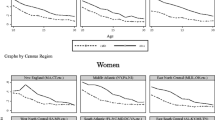Abstract
The growth in single-person households is a pervasive behavioral phenomenon in the United States in the post-war period. In this paper we investigate determinants of the propensity to live alone, using 1970 data across states for single men and women ages 25 to 34 and for elderly widows. Income level appears to be a major determinant of the propensity to live alone. The estimated cross-state equations track about three-quarters of the increase in the propensity to live alone between 1950-1976and suggest that income growth has been the principal identified influence. Other variables found to affect (positively) the propensity to live alone include mobility, schooling level, and for young people a measure of social climate; non-whites appear to have a somewhat lower propensity to live alone.
Similar content being viewed by others
References
Becker, Gary S. 1974. A Theory of Marriage. In T. W. Schultz (ed.), Economics of the Family. Chicago: University of Chicago Press.
—, E. M. Landes, and R. T. Michael. 1977. An Economic Analysis of Marital Instability. Journal of Political Economy 85:1141–1187.
Beresford, J. C., and A. M. Rivlin. 1966. Privacy, Poverty, and Old Age. Demography 3:247–258.
Brady, D. S. 1958. Individual Incomes and the Structure of Consumer Units. American Economic Review 48:269–278.
Carliner, Geoffrey. 1975. Determinants of Household Headship. Journal of Marriage and the Family 37:28–38.
Chevan, A., and J. H. Korson. 1972. The Widowed Who Live Alone: An Examination of Social and Demographic Factors. Social Forces 51:45–53.
Chiswick, Barry R. 1974. Income Inequality. New York: Columbia University Press for National Bureau of Economic Research, Inc.
Cutright, P. 1970. Income and Family Events: Getting Married. Journal of Marriage and the Family 32:628–637.
Fuchs, V. R., R. T. Michael, and S. R. Scott. 1979.A State Price Index. National Bureau of Economic Research Working Paper 320.
Keeley, Michael. 1974.A Model of Marital Formation: The Determinants of the Optimal Age at First Marriage and Differences in Age at Marriage. Ph.D. dissertation, University of Chicago.
Kobrin, F. E. 1976. The Fall of Household Size and the Rise of the Primary Individual in the United States. Demography 13:127–138.
Kuznets, S. 1978. Size and Age Structure of Family Households: Exploratory Comparisons. Population and Development Review 4:187–223.
Preston, S. H., and A. T. Richards. 1975. The Influence of Women’s Work Opportunities on Marriage Rates. Demography 12:209–222.
Ross, Heather L., and Isabel V. Sawhill. 1975. Time of Transition: The Growth of Families Headed by Women. Washington, D.C.: Urban Institute.
Sweet, James A. 1974.The Living Arrangements of the Nonmarried Population. University of Wisconsin Center for Demography and Ecology Working Paper #74-15.
Troll, L. E. 1971. The Family of Later Life: A Decade Review. Journal of Marriage and the Family 33:263–290.
U.S. Bureau of the Census. Census of Population: 1970 Subject Reports, Persons by Family Characteristics, for 1950, 1960 and 1970. Washington, D.C.: U.S. Government Printing Office.
—. 1977. Current Population Reports. Marital Status and Living Arrangements: March 1976. Series P-20, no. 306. Washington, D.C.: U.S. Government Printing Office.
Author information
Authors and Affiliations
Rights and permissions
About this article
Cite this article
Michael, R.T., Fuchs, V.R. & Scott, S.R. changes in the propensity to live alone: 1950–1976. Demography 17, 39–56 (1980). https://doi.org/10.2307/2060962
Issue Date:
DOI: https://doi.org/10.2307/2060962




